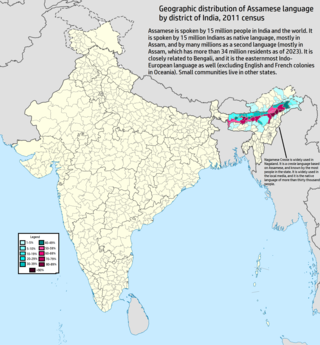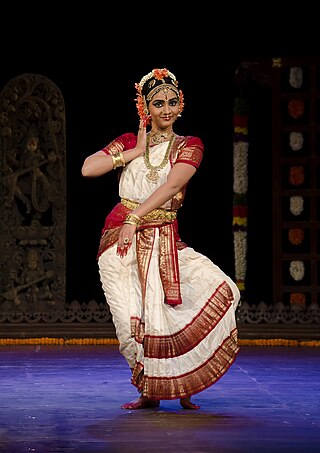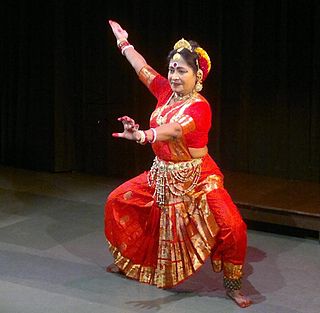Related Research Articles

Assamese or Asamiya is an Indo-Aryan language spoken mainly in the north-eastern Indian state of Assam, where it is an official language. It serves as a lingua franca of the wider region and has over 15 million native speakers according to Ethnologue.

Kuchipudi is one of the eight major Indian classical dances. It originates from a village named Kuchipudi in the Indian state of Andhra Pradesh. Kuchipudi is a dance-drama performance, with its roots in the ancient Hindu Sanskrit text of Natya Shastra. It developed as a religious art linked to traveling bards, temples and spiritual beliefs, like all major classical dances of India.

Kathak is one of the eight major forms of Indian classical dance. Its origin is attributed to the traveling bards in ancient northern India known as Kathakar ("storyteller"), who communicated stories from the Hindu epics and mythology through dance, songs and music. Its name derives from the Sanskrit word katha which means "story", and kathakar which means "the one who tells a story", or "to do with stories".

Sattriya, or Sattriya Nritya, is a major Indian classical dance. It was initially created as part of Bhaona which are performances of Ankiya Nat, one-act plays, originally created by Sankardev, a 15th-16th century polymath from Assam. These dances are part of the living traditions today of Sattra, which are communities of live-in devotees belonging to the Ekasarana Dharma, a Hindu sect established by Sankardev.

Indian classical dance, or Shastriya Nritya, is an umbrella term for different regionally-specific Indian classical dance traditions, rooted in predominantly Hindu musical theatre performance, the theory and practice of which can be traced to the Sanskrit text Natya Shastra. The number of Indian classical dance styles ranges from six to eight to twelve, or more, depending on the source and scholar; the main organisation for Indian arts preservation, the Sangeet Natak Academy recognizes eight: Bharatanatyam, Kathak, Kuchipudi, Odissi, Kathakali, Sattriya, Manipuri and Mohiniyattam. Additionally, the Indian Ministry of Culture includes Chhau in its list, recognising nine total styles. Scholars such as Drid Williams add Chhau, Yakshagana and Bhagavata Mela to the list. Each dance tradition originates and comes from a different state and/or region of India; for example, Bharatanatyam is from Tamil Nadu in the south of India, Odissi is from the east coast state of Odisha, and Manipuri is from the northeastern state of Manipur. The music associated with these different dance performances consists many compositions in Hindi, Malayalam, Meitei (Manipuri), Sanskrit, Tamil, Odia, Telugu, and many other Indian-Subcontinent languages; they represent a unity of core ideas and a diversity of styles, costumes, and expression.

Kamarupi Prakrit is the postulated Middle Indo-Aryan (MIA) Prakrit language used in ancient Kamarupa. This language has been derived from Gauda-Kamarupi Prakrit and the historical ancestor of the Kamatapuri lects and the modern Assamese language; and can be dated prior to 1250 CE, when the proto-Kamta language, the parent of the Kamatapuri lects, began to develop. Though not substantially proven, the existence of the language that predated the Kamatapuri lects and modern Assamese is widely believed to be descended from it.

Santipur is a city and a municipality in the Ranaghat subdivision of Nadia district in the Indian state of West Bengal. The fort area of this city, also known as Daak-Garh is thought to have been built by Raja Krishnachandra of Nadia.
Nalbari is a small town in Nalbari district in the Indian state of Assam. Nalbari is also the headquarters of Nalbari District.

The Kamarupa Anusandhana Samiti is the oldest Research institution in North-East India, which was established in the year 1912 at Kamakhya with a view to working in the field of antiquarian study and research, particularly on the subject of History, Archaeology, Anthropology, Culture etc. It was this society that started the Museum movement for the collection and preservation of antiquities culminating in the birth of the Assam State Museum in 1940.

Kamrupi Lokgeet is popular form of folk music that expresses thoughts and emotion of the Kamrupi people. The songs are derived from Ancient Kamrup. The language of Kamrupi lokgeet are different dialects and ancestral forms of Assamese, including Early Assamese, Kamrupi dialects and Standard Assamese.

Kamrupi dialects are a group of regional dialects of Assamese, spoken in the Kamrup region. It formerly enjoyed prestige status. It is one of two western dialect groups of the Assamese language, the other being Goalpariya. Kamrupi is heterogeneous with three subdialects— Barpetia dialect, Nalbariya dialect and Palasbaria dialect.
Kamrupi dance is group of dances originating in ancient Kamrup, forming one of the cultural norm of region.
Kamrupi culture refers to the cultural norms of people of colonial Kamrup district.

Kamarupi script was the script used in ancient Kamarupa from as early as 5th century to 13th century, from which the modern Assamese script eventually evolved. In the development of the Assamese script, this phase was followed by the medieval and then by the modern Assamese scripts.

Gaudiya Nritya or Gour̤īyo Nrityo, is an ancient Bengali classical dance tradition. It originates from Gauda, also known as Gaur, in Bengal. Gaudiya Nritya is mentioned by ancient poets of Bengal. This dance expressed religious stories through songs written and composed to the ragas & talas of Gaudiya music by ancient poets, especially Vaishnavism. Gaudiya Nritya performances have also expressed ideas of other traditions related to the Hindu deities Shiva and Ganesha, as well as Shakta concepts.
The Kamrupi people are a linguistic group that speak the Kamrupi dialects of Assamese and are found in the colonial Kamrup district region of Assam, India.

Jatin Goswami is an Indian dancer and choreographer, known as one of the prominent exponents of the classical dance form of Sattriya. He is the founder director of Sattriya Akademi, Guwahati, a sitting member of its Advisory Committee, and a former member of the General Council of the Sangeet Natak Akademi. He is also the founder of Alok Shilpi Sangha, a dance academy and Pragjyoti Kala Parishad, a cultural organization, and is a recipient of the 2004 Sangeet Natak Akademi Award. The Government of India awarded him the fourth highest civilian honour of the Padma Shri, in 2008, for his contributions to Sattriya dance.
Bhagavata Mela is a classical Indian dance that is performed in Tamil Nadu, particularly the Thanjavur area. It is choreographed as an annual Vaishnavism tradition in Melattur and nearby regions, and celebrated as a dance-drama performance art. The dance art has roots in a historic migration of practitioners of Kuchipudi, another Indian classical dance art, from Andhra Pradesh to the kingdom of Tanjavur.

Nritya, also referred to as nritta, natana or natya, is "dance, act on the stage, act, gesticulate, play" in the Indian traditions. It is sometimes subdivided into two forms: nritta or pure dance, where the expressionless movements of a dancer play out the rhythms and phrases of the music; and nritya or expressive dance, where the dancer includes facial expression and body language to portray mood and ideas with the rhythmic movements.